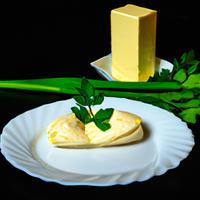
1 serving (14 grams) contains 100 calories, 0.0 grams of protein, 11.0 grams of fat, and 0.0 grams of carbohydrates.

Log this food in SnapCalorie

Nutrition Information
Calories |
1700.7 | ||
|---|---|---|---|
% Daily Value* |
|||
| Total Fat | 187.1 g | 239% | |
| Saturated Fat | 119.0 g | 595% | |
| Polyunsaturated Fat | 0 g | ||
| Cholesterol | 510.2 mg | 170% | |
| Sodium | 17.0 mg | 0% | |
| Total Carbohydrates | 0 g | 0% | |
| Dietary Fiber | 0 g | 0% | |
| Sugars | 0 g | ||
| protein | 0 g | 0% | |
| Vitamin D | 0 mcg | 0% | |
| Calcium | 51.0 mg | 3% | |
| Iron | 0 mg | 0% | |
| Potassium | 51.0 mg | 1% | |
* Percent Daily Values are based on a 2,000 calorie diet. Your daily values may be higher or lower depending on your calorie needs.
Food Attributes
Source of Calories
About Grass-fed butter
Grass-fed butter is a rich, flavorful dairy product made from the milk of cows raised on pastures and fed primarily on grass. This butter is prized for its creamy texture and vibrant yellow hue, which comes from higher levels of carotenoids. Nutritionally, it contains beneficial fats, including omega-3 fatty acids and conjugated linoleic acid (CLA), both linked to heart health and anti-inflammatory properties. Grass-fed butter also provides fat-soluble vitamins like A, D, and K2, essential for bone and immune health. Originating from traditional farming practices, it’s a staple in many cuisines, including European, where it's used in baking, sauces, and as a spread. While grass-fed butter is full of nutrients, it is still high in saturated fat and calories, so moderation is key. Ideal for ketogenic and paleo diets, it’s a wholesome, natural alternative to conventionally produced butter.



